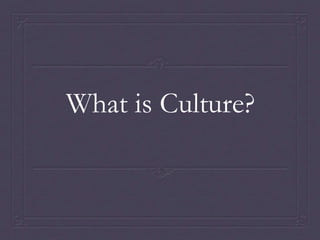
Intro to Mexican Culture
- 2. Objective • I can define what culture is. • I can explain how culture impacts a group of people. • I can compare the culture in Mexico with the United States.
- 3. Culture • Culture is a dynamic system of rules, both explicit and implicit, established by groups to ensure their survival. These include values, beliefs, norms, and customs. • Dynamic: Changing over time and from place to place. • Explicit: Written rules such as laws. • Implicit: Unspoken rules.
- 4. Objects of Culture • Religion • Language • Clothing • Food • Education • Art
- 5. Cultural Norms • Cultural Norms are behaviors that are passed down from generation to generation and through other gatekeepers. These include media, religious leaders, teachers, and peers.
- 6. Comparing the Complexities of Culture
- 7. Cultural Dimensions • Different characteristics of a culture based on values and cultural norms.
- 8. Power Distance • The extent to which the less powerful members of organizations and institutions (like the family) accept and expect that power is distributed unequally.
- 9. Uncertainty Avoidance • Uncertainty Avoidance is not the same as risk avoidance; it deals with a society's tolerance for ambiguity. It indicates to what extent a culture programs its members to feel either uncomfortable or comfortable in unstructured situations. • High Uncertainty Avoidance: Do not like new experiences or ambiguity. • Low Uncertainty Avoidance: Do not mind or enjoy new experiences or ambiguity.
- 10. Individualism & Collectivism • Individualism: Cultures that stress the needs of the individual over the needs of the group. • Collectivism: Cultures that stress the needs of the group over the needs of the individual.
- 11. Masculinity - Femininity • The type of value that society values. Not a measure of gender roles. • Masculinity: Assertiveness, Work over family, Admiration for the strong, Fathers make decisions, religious focus on God of gods, Boys don’t cry. • Femininity: Limited emotional differences between genders, sympathy for the weak, Religious focus on other humans.
- 12. Long-Term & Short-Term Orientated • Short-Term: The present and past are most important. Live in the now. Hedonistic. Traditions and cultures remain the same. • Long-Term: The future is most important. Change is important. Live for tomorrow.
- 13. Indulgence & Restraint • Indulgence: A society that allows relatively free gratification of basic and natural human desires related to enjoying life and having fun. • Restraint: A society that controls gratification of needs and regulates it by means of strict social norms.
- 14. Mexico: Power Distance • 81/100: People accept a hierarchical order in which everybody has a place and which needs no further justification. Hierarchy in an organization is seen as reflecting inherent inequalities, centralization is popular, subordinates expect to be told what to do and the ideal boss is a benevolent autocrat.
- 15. Mexico: Individualism • 30/100: Mexico, with a score of 30 is considered a collectivistic society. This is manifest in a close long-term commitment to the member 'group', be that a family, extended family, or extended relationships. Loyalty in a collectivist culture is paramount, and over-rides most other societal rules and regulations. The society fosters strong relationships where everyone takes responsibility for fellow members of their group.
- 16. Mexico: Masculinity/Femininity • 69/100: Mexico scores 69 on this dimension and is thus a Masculine society which is driven by competition, achievement and success, with success being defined by the winner/best in field – a value system that starts in school and continues throughout organizational life.
- 17. Mexico: Uncertainty Avoidance • 82/100: Mexico scores 82 on this dimension and thus has a very high preference for avoiding uncertainty. Countries exhibiting high Uncertainty Avoidance maintain rigid codes of belief and behaviour and are intolerant of unorthodox behaviour and ideas. In these cultures there is an emotional need for rules (even if the rules never seem to work) time is money, people have an inner urge to be busy and work hard, precision and punctuality are the norm, innovation may be resisted, security is an important element in individual motivation.
- 18. Mexico: Long-Term vs. Short-Term • 24/100: The relatively low score of 24 means that the Mexican culture is normative. People in such societies have a strong concern with establishing the absolute Truth; they are normative in their thinking. They exhibit great respect for traditions, a relatively small propensity to save for the future, and a focus on achieving quick results.
- 19. Mexico: Indulgence • 97/100: With a very high score of 97, Mexican culture has a definite tendency toward Indulgence. People in societies classified by a high score in Indulgence generally exhibit a willingness to realize their impulses and desires with regard to enjoying life and having fun. They possess a positive attitude and have a tendency towards optimism. In addition, they place a higher degree of importance on leisure time, act as they please and spend money as they wish.
- 20. Exploring Mexico’s Culture • Read one subsection on the following website: • Exploring Mexico's Culture • Record examples from the reading that defend the cultural dimensions of Mexico. • Food & Economy • Social Stratification • Political Life • Gender Roles • Religion • Other choices
- 21. One Beautiful Sentence • Mexico’s cultural dimension of ______________ can be seen in the way that ___________________ . .